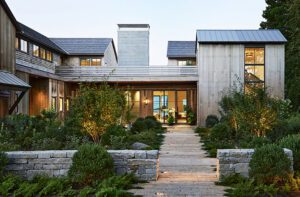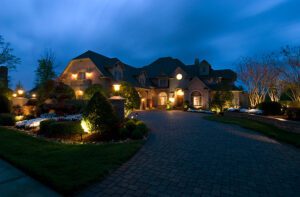The Science of Art
November 3, 2010
Text by Regina Cole Photography by Trent Bell Produced by Kyle Hoepner
The owner of Mount Desert Island’s most compelling new vacation home wrote to his architect soon after moving in. “He hosted an art exhibit in his house, and at one point he stood on the porch and looked in at the big party,” says Peter Forbes, who practices architecture from offices in Maine and Florence, Italy. “A scientist to his bones,” Forbes relates, “he wrote that, as he watched people move through the house, it was like seeing red blood cells coursing through transparent arteries. When I read those words, I knew that I had built the right house for my client.”
The house, 7,000 square feet including the garage, presents itself as a two-story tube emerging from the trees to the brink of a ledge high above the Atlantic Ocean. As it moves from woods toward sea, it breaks and bends. Curving and cantilevered walls wear traditional white cedar shingles; as the structure approaches the view, it dissolves into rooms enclosed within impossibly clear glass. A length of clerestory windows crowns the ridgepole, giving the slender house elegant height.
Forbes sited the house on the east side of a ridge with what he calls a “traditional, view-driven orientation” that makes for great vistas but presents a challenge when it comes to drawing in light. “All those old coastal Maine summer places are full of sunshine in the morning, but gloomy in the afternoon. Light in Maine is the most precious commodity,” Forbes says. “This house reaches up and grabs the afternoon light and brings it into every room. Every space is designed to catch the light, and every bedroom has at least one balcony. The enemy of light is depth, so the house is narrow: one room deep.”
The house perches on one of Acadia’s steep hillsides on steel pilings, extensions of its central frame. There is no basement or foundation: the steel ties into granite ledge. The variously curving and slanting walls float on the “structural spine,” as Forbes calls it, creating a delicate footprint.
The yard consists of tall spruce and Balsam fir trees, lichened boulders and outcroppings of ledge, stands of fern and low-bush blueberry. Especially when enshrouded with coastal Maine’s ubiquitous fog, the house resembles an organic part of Longfellow’s forest primeval. “Our goal was to make it seem as though the landscape had never been touched,” says landscape architect Michael Boucher of Freeport, Maine.
Boucher’s work with modern architecture, in particular, redefines standard notions of landscape design. “I like to create landscapes that are extensions of architecture,” he says. “In this case, we built a bridge, stairs, patios and a trail network around the house with deliberately crafted granite pieces. We get people to the front door while they don’t know where they’re headed.”
A gravel and stone-dust path meanders past young maple and birch trees, into deep forest, over a large, smooth rock outcropping, then toward a front door located at the axis of the house. The door leads into a glass-enclosed stairwell; to either side, walls peel away into curves enclosing porches and decks and outdoor stairs. One wing holds the kitchen, dining room, living room and master bedroom. Guest rooms occupy the opposite section. The transparent stair hall literally floats in space. “You can walk under the house,” Forbes says. “In the spring, water rushes under the bridge.”
Forbes’s design makes the home feel intimate despite its expansiveness. “The two sections and the curves diminish the size: you are never aware of how big the house is because you never see a big block of house,” he says.
The stairs have handsome white oak treads and risers over structural lead coated copper; a tactile white oak handrail crowns the stainless steel cable railings. White oak floors lead to rooms clad with horizontal white beadboard. In the living room and the master bedroom, the walls melt away into transparency. Manufactured to stringent specifications in Italy, this glass has none of the green hue common to the material. On the second floor, the slanted horizontal board ceiling reaches up towards the clerestory. “Breaking through the roof with the clerestory was much like piercing a roof with a chimney,” says Corey Papadopoli, a Bar Harbor–based architect who, at the time, worked with Peter Forbes. “The clerestory is lined with aluminum frame windows; they open to draw hot air up and out of the house. The design posed the same issues as a chimney: the challenge of keeping water out, which called for flashing.”
The long, narrow clerestory features fold-down seats built into the beadboard walls. “This is where the homeowner likes to go bird watching, or to look at the night sky,” Papadopoli explains.
Forbes describes the Boston-based homeowner as the ideal client, though not for the usual reasons. “He applied his scientific method to the design process; he takes nothing for granted. When an idea is proposed, he begins testing.”
Forbes believes that he won the commission because he came to the table without preconceptions, an attitude suited to a scientific approach. “When we first met and the owner asked what I would do, I answered ‘I don’t know.’”
He designed the interior with clean lines and light-reflecting surfaces. Electrical and ventilation elements hide from view; classic pieces from the mid-twentieth century and from contemporary Maine craftsmen furnish rooms focused on the outdoors. Opposite the view in the living room, a massive fireplace built of local granite tapers to a chimney that pierces the ceiling and passes through the master bedroom on its way to the clerestory and the sky above.
The homeowner had one stylistic prohibition. “He was very clear: no oriental rug,” Peter Forbes recalls. “For him, it represents the predictable and unimaginative.”
The master bath embodies the spirit of the house with a curved vanity, an Italian travertine vessel sink, honed granite walls and floor and, hung before a window, “the world’s coolest mirror,” says Forbes. “It’s a one-way mirror that becomes transparent at night. It still reflects, but you also see through it to the woods outside.”
The mirror could almost stand as a symbol for the house itself: grounded in sound principles, designed and built with the most modern scientific methods, yet yielding a result that feels like sheer magic.
Architecture: Peter Forbes
Landscape Architecture: Michael Boucher
Share
![NEH-Logo_Black[1] NEH-Logo_Black[1]](https://b2915716.smushcdn.com/2915716/wp-content/uploads/2022/08/NEH-Logo_Black1-300x162.jpg?lossy=1&strip=1&webp=1)




















You must be logged in to post a comment.